Wireless Sensor Network Technologies for Temperature Monitoring
Wireless Sensor Network Technologies for Temperature Monitoring in Building Services in Hong Kong (Focus on Internet of Things)
33 Pages7757 Words21 Views
Added on 2022-08-31
Wireless Sensor Network Technologies for Temperature Monitoring
Wireless Sensor Network Technologies for Temperature Monitoring in Building Services in Hong Kong (Focus on Internet of Things)
Added on 2022-08-31
ShareRelated Documents
WIRELESS SENSOR NETWORK TECHNOLOGIES FOR TEMPERATURE
MONITORING IN BUILDING SERVICES
WITH FOCUS ON THE INTERNET OF THINGS (IOT) IN HONGKONG
By Name
Course
Instructor
Institution
Location
Date
MONITORING IN BUILDING SERVICES
WITH FOCUS ON THE INTERNET OF THINGS (IOT) IN HONGKONG
By Name
Course
Instructor
Institution
Location
Date

ABSTRACT
The presented notion highlights a modified and enabled Wireless Sensing and Monitoring
Platform called Internet of Things (IoT) mainly at the building automation context for
scrutinizing the relative humidity, light and temperature. Most of the systems which have highly
developed a customized hopping technique are employed to monitor the transfer of data to the
receiver node from the transmitter node. On receiving the data, monitoring and recording is done
in an excel sheet in a personal computer by the help of GUI (Graphical User Interface) which is
designed in labVIEW. Vigorous development has also been made on the android application to
enable the transfer of data to a smartphone from the labVIEW to allow remote monitoring of
data.
The presented notion highlights a modified and enabled Wireless Sensing and Monitoring
Platform called Internet of Things (IoT) mainly at the building automation context for
scrutinizing the relative humidity, light and temperature. Most of the systems which have highly
developed a customized hopping technique are employed to monitor the transfer of data to the
receiver node from the transmitter node. On receiving the data, monitoring and recording is done
in an excel sheet in a personal computer by the help of GUI (Graphical User Interface) which is
designed in labVIEW. Vigorous development has also been made on the android application to
enable the transfer of data to a smartphone from the labVIEW to allow remote monitoring of
data.
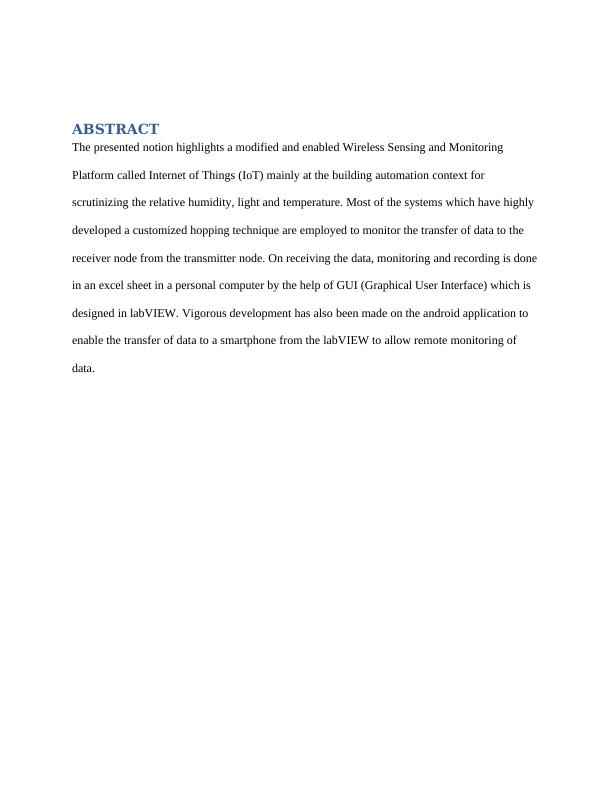
Contents
ABSTRACT.................................................................................................................. 2
ACKNOWLEDGEMENT................................................................................................. 3
DECLARATIONS........................................................................................................... 4
List of Tables........................................................................................................... 4
List of figures........................................................................................................... 4
INTRODUCTION........................................................................................................... 5
AIMS AND OBJECTIVES................................................................................................ 7
LITERATURE REVIEW.................................................................................................. 7
Overview of the smart home overview....................................................................8
Services of Smart Homes........................................................................................ 9
Home conditions measurement........................................................................... 9
Management of Home Appliances.........................................................................10
METHODOLOGY........................................................................................................ 10
Description of the System and Data Acquisition in Experimental Work................10
Node...................................................................................................................... 11
Sensor................................................................................................................... 12
Micro-controller..................................................................................................... 14
Wireless Trans receiver......................................................................................... 14
Consideration for the installations of WSN............................................................16
Graphical User Interface........................................................................................ 17
Android Application............................................................................................... 18
RESULTS AND DISCUSSIONS.................................................................................... 19
Findings and disposition from the conducted experiments................................19
The results of repeater node and sensor battery voltage......................................20
CONCLUSIONS AND RECOMMENDATIONS FOR THE FUTURE WORK.........................24
REFERENCES............................................................................................................ 25
APPENDICES............................................................................................................. 26
ABSTRACT.................................................................................................................. 2
ACKNOWLEDGEMENT................................................................................................. 3
DECLARATIONS........................................................................................................... 4
List of Tables........................................................................................................... 4
List of figures........................................................................................................... 4
INTRODUCTION........................................................................................................... 5
AIMS AND OBJECTIVES................................................................................................ 7
LITERATURE REVIEW.................................................................................................. 7
Overview of the smart home overview....................................................................8
Services of Smart Homes........................................................................................ 9
Home conditions measurement........................................................................... 9
Management of Home Appliances.........................................................................10
METHODOLOGY........................................................................................................ 10
Description of the System and Data Acquisition in Experimental Work................10
Node...................................................................................................................... 11
Sensor................................................................................................................... 12
Micro-controller..................................................................................................... 14
Wireless Trans receiver......................................................................................... 14
Consideration for the installations of WSN............................................................16
Graphical User Interface........................................................................................ 17
Android Application............................................................................................... 18
RESULTS AND DISCUSSIONS.................................................................................... 19
Findings and disposition from the conducted experiments................................19
The results of repeater node and sensor battery voltage......................................20
CONCLUSIONS AND RECOMMENDATIONS FOR THE FUTURE WORK.........................24
REFERENCES............................................................................................................ 25
APPENDICES............................................................................................................. 26
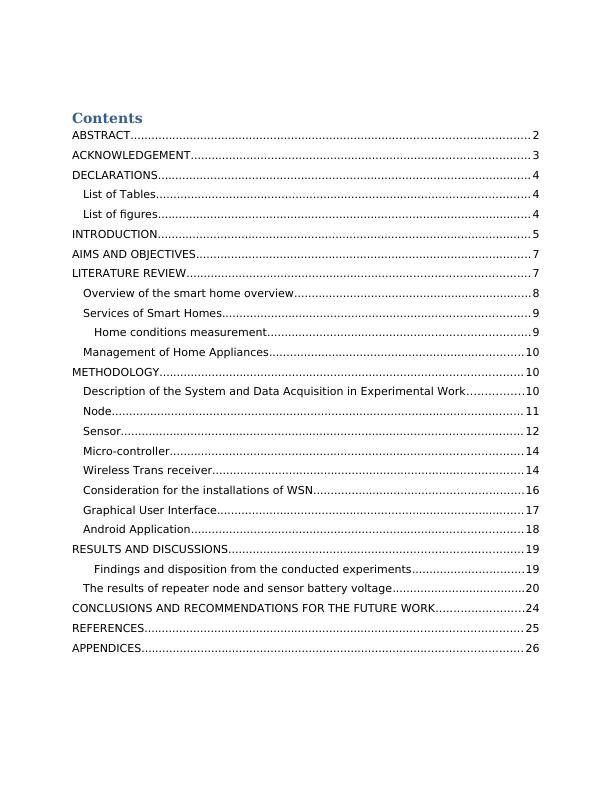
ACKNOWLEDGEMENT
It is of common knowledge that a project can only be regarded complete when it is supplemented
by words of encouragement. And for that I’m totally obliged to Mr...................... for being of
great help to the team in providing the correct path and relative suggestions throughout the entire
project. I may lack the exact words to express my thanks to him but I greatly submit to his help,
for he provided the vigorous effort in the endeavor, observing a close interaction in every step I
made and providing me with the necessary advice at every stage of the project development. Let
me pass my gratitude to those whom I have interacted with for their contribution and the
responsibilities they have observed.
It is of common knowledge that a project can only be regarded complete when it is supplemented
by words of encouragement. And for that I’m totally obliged to Mr...................... for being of
great help to the team in providing the correct path and relative suggestions throughout the entire
project. I may lack the exact words to express my thanks to him but I greatly submit to his help,
for he provided the vigorous effort in the endeavor, observing a close interaction in every step I
made and providing me with the necessary advice at every stage of the project development. Let
me pass my gratitude to those whom I have interacted with for their contribution and the
responsibilities they have observed.

DECLARATIONS
I declare that this particular is my own original work and has never been used in the award of degree
or masters in any University.
List of Tables
Table 1: Consumption of current by Sensors
Table 2: Consumption of current by microcontrollers
Table 3: Voltage and current Modules
Table 4: A table of reliability of data transmission
Table 5: A table showing duration of various states of wireless sensor node
Table 6: A table showing the sensor node calculation
List of figures
Figure 1: Figure showing a block diagram for the proposed system
Figure 2: Figure of the suggested wireless sensor node
Figure 3: Graphical User Interface
Figure 4: A figure showing results of temperature humility and light.
Figure 5: Transmission and sensing methodology
I declare that this particular is my own original work and has never been used in the award of degree
or masters in any University.
List of Tables
Table 1: Consumption of current by Sensors
Table 2: Consumption of current by microcontrollers
Table 3: Voltage and current Modules
Table 4: A table of reliability of data transmission
Table 5: A table showing duration of various states of wireless sensor node
Table 6: A table showing the sensor node calculation
List of figures
Figure 1: Figure showing a block diagram for the proposed system
Figure 2: Figure of the suggested wireless sensor node
Figure 3: Graphical User Interface
Figure 4: A figure showing results of temperature humility and light.
Figure 5: Transmission and sensing methodology
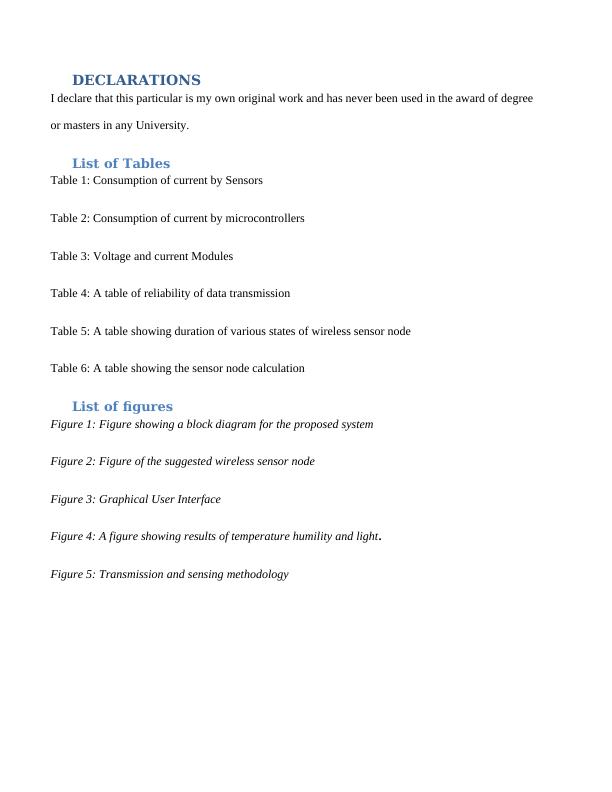
INTRODUCTION
The Internet of Things (IoT) is also said to be physical objects’ network and comprises of electronics,
software and sensors with inter-relational communication between them together with the users of the
system. IoT has shown rapid evolution following the convergence of technologies applied in
communication, information as well as the internet. It has a number of applications even within the
urban context one being smart building which assures an improvement in the standards of living of
the inhabitants with the help of improvised technology in communications and information. With
smart building, some of the services of augmented superiority include management in the quality of
air to improve the a better condition of the environment and reduce pollution effects, and to facilitate
public buildings to minimize the efforts applied by human beings and also to lower the amount of
energy consumed in the process (Tang et al.2016).
Intensive efforts have been implemented with the help of Wireless Sensor Network (WSN) to
monitor the microclimate conditions. Authors have given in their reports on monitoring the quality of
air indoor through estimating the levels of pollution for the environments within the houses of
residents while in some of their reports they have given information concerning energy autonomy for
sensor node. In the current life state, human beings encounters a lot concerning the parameters of the
environment including humidity, light and temperature and they stab to adjust manually. WNS has
made monitoring of such parameters easier and at the same time has improved the suitability of the
system with no great changes in the infrastructure. For home automation which is a section of
building automation, the monitoring system provides security and comfort to the individuals and also
energy saving mechanisms through taking a close observation at the amount of energy consumed in a
day (Abuarqoub et al.2017).
The Internet of Things (IoT) is also said to be physical objects’ network and comprises of electronics,
software and sensors with inter-relational communication between them together with the users of the
system. IoT has shown rapid evolution following the convergence of technologies applied in
communication, information as well as the internet. It has a number of applications even within the
urban context one being smart building which assures an improvement in the standards of living of
the inhabitants with the help of improvised technology in communications and information. With
smart building, some of the services of augmented superiority include management in the quality of
air to improve the a better condition of the environment and reduce pollution effects, and to facilitate
public buildings to minimize the efforts applied by human beings and also to lower the amount of
energy consumed in the process (Tang et al.2016).
Intensive efforts have been implemented with the help of Wireless Sensor Network (WSN) to
monitor the microclimate conditions. Authors have given in their reports on monitoring the quality of
air indoor through estimating the levels of pollution for the environments within the houses of
residents while in some of their reports they have given information concerning energy autonomy for
sensor node. In the current life state, human beings encounters a lot concerning the parameters of the
environment including humidity, light and temperature and they stab to adjust manually. WNS has
made monitoring of such parameters easier and at the same time has improved the suitability of the
system with no great changes in the infrastructure. For home automation which is a section of
building automation, the monitoring system provides security and comfort to the individuals and also
energy saving mechanisms through taking a close observation at the amount of energy consumed in a
day (Abuarqoub et al.2017).
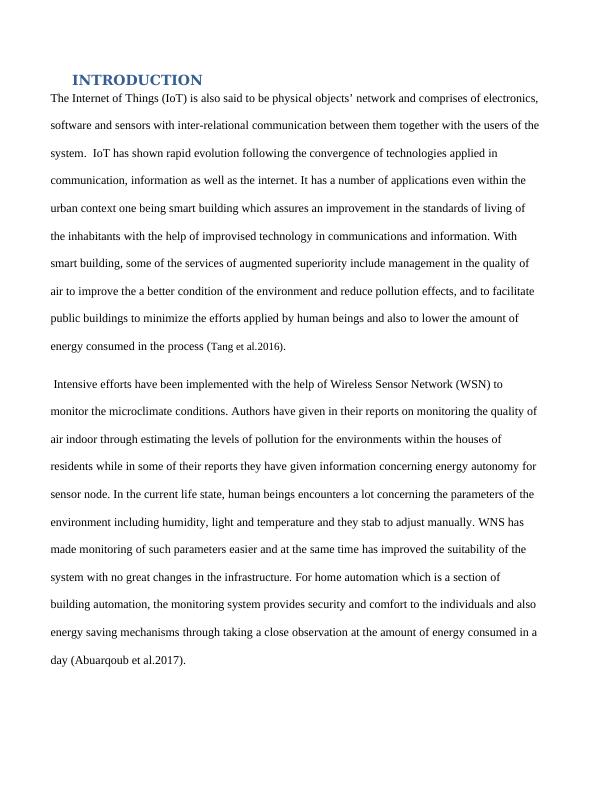
A section of this paper also discusses an integration system for the IoT and home monitoring system,
another part also provides a discussion on the monitoring system based on WSN to evaluate the
effectiveness of elderly through scrutinizing their day to day operations. In other sections, authors
provide a discussion on the developed middleware for intellect ambient applications like home
automation. In addition to that, other discussions concerning control system and smart power
monitoring system for household appliances are highlighted in other sections which are still under
building automation.
This thesis suggests a more developed IoT with enabled Wireless Sensing and Monitoring Platform
(IoT-WSMP) that takes a close observation on the essential environmental building automation
parameters including light, humidity and temperature in Hongkong. LabVIEW provides a
development platform for Graphical User Interface (GUI) that avails a graph for persistent recording
and monitoring of data concerning environmental parameters. The data which have been recorded
may be used later for extended analysis and to control the building environment. The local
application, android, is of much importance for remote monitoring. On receiving the data, monitoring
and recording is done in an excel sheet in a personal computer by the help of GUI (Graphical User
Interface) which is designed in labVIEW. Vigorous development has also been made on the android
application to enable the transfer of data to a smartphone from the labVIEW to allow remote
monitoring of data (Paiz et al.2010).
This thesis follows a specific structure, that is, first section presenting the structure of the projected
WSN as well as the mechanism applied for the transmission and sensing of data. Closely following is
the section that presents findings to the conducted experiments as per the validation and
implementation of the proposed system at development stage. The paper then concludes by
discussing probable on latent imminent activities.
another part also provides a discussion on the monitoring system based on WSN to evaluate the
effectiveness of elderly through scrutinizing their day to day operations. In other sections, authors
provide a discussion on the developed middleware for intellect ambient applications like home
automation. In addition to that, other discussions concerning control system and smart power
monitoring system for household appliances are highlighted in other sections which are still under
building automation.
This thesis suggests a more developed IoT with enabled Wireless Sensing and Monitoring Platform
(IoT-WSMP) that takes a close observation on the essential environmental building automation
parameters including light, humidity and temperature in Hongkong. LabVIEW provides a
development platform for Graphical User Interface (GUI) that avails a graph for persistent recording
and monitoring of data concerning environmental parameters. The data which have been recorded
may be used later for extended analysis and to control the building environment. The local
application, android, is of much importance for remote monitoring. On receiving the data, monitoring
and recording is done in an excel sheet in a personal computer by the help of GUI (Graphical User
Interface) which is designed in labVIEW. Vigorous development has also been made on the android
application to enable the transfer of data to a smartphone from the labVIEW to allow remote
monitoring of data (Paiz et al.2010).
This thesis follows a specific structure, that is, first section presenting the structure of the projected
WSN as well as the mechanism applied for the transmission and sensing of data. Closely following is
the section that presents findings to the conducted experiments as per the validation and
implementation of the proposed system at development stage. The paper then concludes by
discussing probable on latent imminent activities.
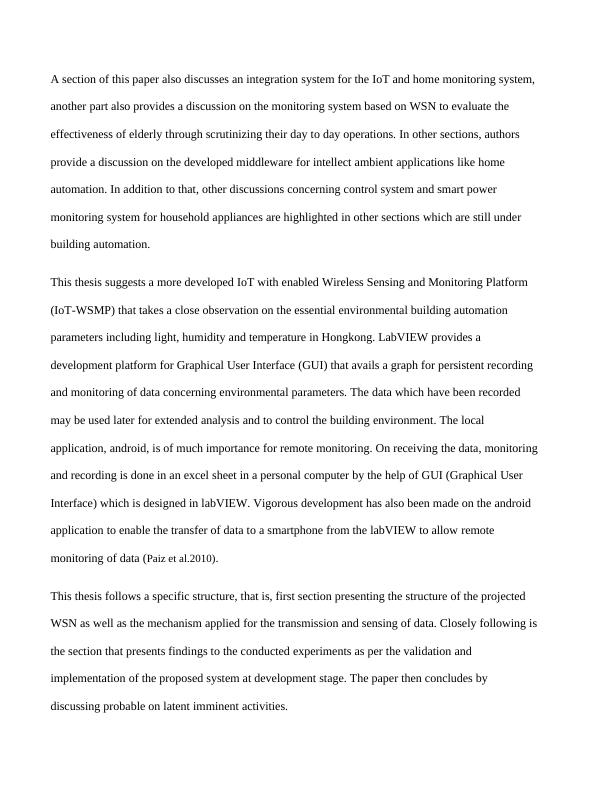
AIMS AND OBJECTIVES
To generate a customized IoT enabled wireless sensing and monitoring platform (IoT-WSMP)
which is capable of monitoring temperature, light and humidity as the key parameters in
building services automation in Hongkong.
To develop a Graphical User Interface (GUI) capable of providing a graph to be used in
monitoring as well as recording data in the LabVIEW.
LITERATURE REVIEW
Internet of things, classic smart home, cloud computing as well as processes sing of rule-based
events have been identified as the building blocks of the of the advanced smart home which is
basically an integrated compound. The practice is not only limited to Hongkong but it is being
practiced in mot arts of the world. Each and every component that has been highlighted contributes
its crucial technologies as well as attributes to the composition which has been proposed. There is
contribution of the internet connection by the IoT . This component is also responsible for the remote
management of the appliances which have been identified as mobile and this is the reason of its in
cooperation by several sensors. It is possible to have an attachment of the sensors to the appliances of
home including lights, air-conditioning as well as other devices used for the environment.
It is also responsible for embedding the system of the computer intelligence into the devices of
home. This implies that it is responsible for the provision of mechanisms of measuring conditions of
homes as well as assists in monitoring the functionality of the home appliances. Through cloud
computing, there would be provision of scalable computing power, its applications as well as spaces
of storages. These are meant for the development, maintenance as well as running of home services
hence leading to ease of access to the devices of homes at any time anywhere. The event processes
system which is actually rule-based assist in the provision proper control as well as orchestration of
To generate a customized IoT enabled wireless sensing and monitoring platform (IoT-WSMP)
which is capable of monitoring temperature, light and humidity as the key parameters in
building services automation in Hongkong.
To develop a Graphical User Interface (GUI) capable of providing a graph to be used in
monitoring as well as recording data in the LabVIEW.
LITERATURE REVIEW
Internet of things, classic smart home, cloud computing as well as processes sing of rule-based
events have been identified as the building blocks of the of the advanced smart home which is
basically an integrated compound. The practice is not only limited to Hongkong but it is being
practiced in mot arts of the world. Each and every component that has been highlighted contributes
its crucial technologies as well as attributes to the composition which has been proposed. There is
contribution of the internet connection by the IoT . This component is also responsible for the remote
management of the appliances which have been identified as mobile and this is the reason of its in
cooperation by several sensors. It is possible to have an attachment of the sensors to the appliances of
home including lights, air-conditioning as well as other devices used for the environment.
It is also responsible for embedding the system of the computer intelligence into the devices of
home. This implies that it is responsible for the provision of mechanisms of measuring conditions of
homes as well as assists in monitoring the functionality of the home appliances. Through cloud
computing, there would be provision of scalable computing power, its applications as well as spaces
of storages. These are meant for the development, maintenance as well as running of home services
hence leading to ease of access to the devices of homes at any time anywhere. The event processes
system which is actually rule-based assist in the provision proper control as well as orchestration of

End of preview
Want to access all the pages? Upload your documents or become a member.
Related Documents
SIT740 - Research and Development in Information Technologylg...
|5
|614
|54
Wireless Weather Station Project Reportlg...
|9
|1293
|82
IoT Smart Citieslg...
|32
|11509
|41
